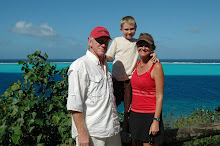Today Jo, Bear and I went ashore to meet the family that lives on Albert Bay where we are anchored on Rabi Island. We had also heard of a jungle hike over the hill to the other side and hoped that someone would guide us there. Both of our goals were met - and then some.
 | |
| Inside the home |
 |
| Thatch roof house |
We were welcomed ashore by Mariana, a 53 year old Fijian-Banaba native. Let me explain. Rabi (pronounced ram-bi) Island was used as a resettlement island for the people of Banaba Island (or Ocean Island in the Gilbert Islands, currently part of Kiribati) which was destroyed from over-mining phospates during WWII. The English, in their guilt, relocated the native Gilbertese people to this island in Fiji in 1945 where their 4,500 descendents now live. The current population has adopted some of the Fijian customs, such as kava drinking, but they also maintain their Gilbertese language and customs. The people have a more Asian look of the Micronesian inhabitants of the northern islands. Mariana's mother was one of these transplanted people and her father was Fijian.
 |
| The Old Man weaves a basket |
Mariana immediately invited us into the nearby open-air, two-room, thatched roof house where we were introduced to “the old man” who sat on the matted floor rolling and smoking Fijian tobacco (as far as we could tell, it was only tobacco, not weed) with Mariana’s husband, Terri. “The Old Man” (which is how he was referred by his family) reminded us of Mr. Miachi from the Karate Kid. He had the same look about him: long, white hair hanging to his shoulders, a headband wrapping his head and eyes that twinkled with pleasure but were sage in depth. For an hour, we sat on the floor and learned about the family, the island and the history of the people. Mariana and The Old Man spoke fairly good English so we were able to understand most of what they said. Their mother tongue is the native language of Banaba.
Next to us, in the same room, was a raised platform area for sleeping. Underneath the platform, pigs slept lazily in the dirt while piglets rooted the soil. In one corner on the bed, two chickens roosted, protecting at least two eggs that we saw. The Old Man claimed to have nine pigs and we saw many chickens with chicks roaming the nearby area. Although these are good sources of protein, their core protein comes from the sea: fish, lobsters, clams, octopus, prawns, turtles and other shellfish. Daily we saw the men snorkeling or fishing in boats for food. They also harvest the sea cucumbers to sell for large sums of money ($40-$90 each!) that eventually go to Japan.
Living almost totally sustainably, the island provides the balance of their diet. For starch, they eat root vegetables (kasava and taro) and also breadfruit which grows on trees. Fruit grows in abundance in this climate as well: papaya, pineapple, bananas, coconuts and watermelon. The only thing that they are light on is green vegetables. Mariana pointed out some leave plants that they eat but it is rare to see the common green vegetables that North Americans are used to. Staples like sugar and flour are purchased in town which is only accessible by boat.
Mariana explained that she and Terri are living with The Old Man temporarily until they build their own house a short distance down the beach. They had planned to start building today but instead offered to take us on the hike. Upon hearing this, we tried to forgo the hike but they insisted. “We can always build the house tomorrow,” they said.
“How long does it take to build a house?” we asked innocently.
Terri shrugged, “Three days, maybe four.” We were stunned. But being in no hurry, we set off on the hike.
 |
| Terri cuts a coconut to drink |
Our goal was up and over the hill to the bay on the other side of the island. Terri slashed our way through the jungle on a path identifiable only by him. Bear had his machete too but the vines and plants were too tough for him to make much difference. Mariana brought up the rear and pointed out plants along the way and explained their purpose. The trek over took an hour and the beach on the opposite side was empty of water as the tide was out. For this reason, Terri suggested that we walk around the island on the return and claimed it was equidistant to our hike over, except flat. This sounded good. But it turned out to be over two hours in the hot sun! Along the way, we saw lots of crabs, fire worms and brittle stars in the tidal waters. Terri climbed a coconut tree for coconut water refreshment along the way and Mariana picked some papaya for us.
 |
| Banana bunch from Terri |
 |
| Terri (left) and Mariana (right) with family |
Back at the house, we were all hot and tired. We sat with The Old Man again for a while and he ordered others to gather gifts for us. We left with a bunch of bananas (over 75 of them!), papaya, coconuts, kasava root and limes. We were humbled by how generous they were. In return we later brought in some kava, canned meat and purchased a fish from them. It was a fantastic cultural experience and we are grateful for Terri and Mariana’s hospitality on their lovely island.

